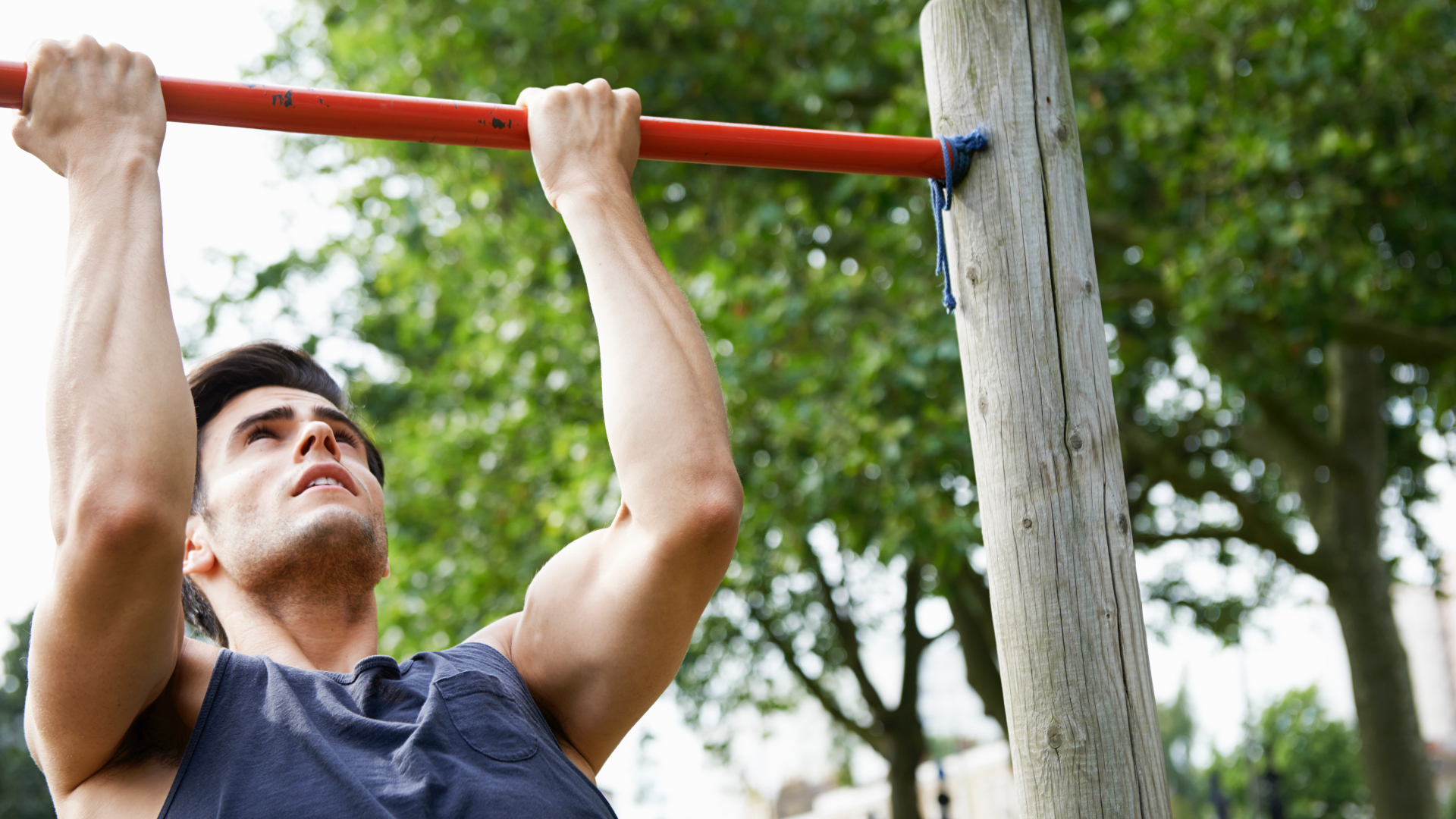What does AMRAP mean - and why is it so good for us?
Confused about AMRAP workouts? We break down everything you need to know - including why they're so effective


Fitness lingo can often be confusing - so if you've been left scratching your head and wondering 'what does AMRAP mean?', then rest assured you're not alone.
It's an increasingly common fitness term that you'll typically hear in relation to CrossFit-style workouts. To the uninitiated it can sound a bit daunting, but in reality it's very straightforward - as we'll outline in this article.
So lace-up your best cross training shoes and prepare to embrace the AMRAP workout!
What is an AMRAP workout?
AMRAP is an initialism that stands for 'as many rounds as possible'. It's a form of high-intensity workout that is guaranteed to make you sweat.
During an AMRAP workout, you're expected to complete as many rounds - or 'reps' - as possible of a particular set of moves in a given timeframe.
The key difference between AMRAP workouts and those that specify the number of reps to complete is that the reward depends on your own effort and exertion. The harder you work, the more rounds or reps you’ll complete - and ultimately the more calories you'll burn.
The emphasis is on you to push yourself to your limits during an AMRAP workout, as Ryan Lucas-Lowther - a CrossFit coach at Fortitude Fitness - explains. ‘They are designed to go at an intense pace to get as much work done in the time given.
Start your week with achievable workout ideas, health tips and wellbeing advice in your inbox.
‘AMRAPs really help build your conditioning and endurance and allow you to see how much you can push yourself in that time frame. These workouts can also be mentally challenging.’
As for who they are suited to? Despite them sounding a little intimidating, anyone and everyone can practice AMRAP workouts - it's just about adapting them to suit your ability.
Why are AMRAP workouts effective?
AMRAP workouts are a great addition to your exercise regime for a number of reasons, as they provide a multitude of benefits.
Suitable for all levels
AMRAPs are really versatile and can benefit any level of fitness – whether you’re totally new to exercise or an elite athlete.
‘Everyone can work at their own pace and fitness level and still reap rewards – a beginner might do less reps than an experienced fitness pro, but the level of effort completed may be just the same, or even more,’ says CrossFit athlete Aimee Cringle.
If you are a beginner, you can scale the movements/reps down to something that's challenging for you.
However, Lucas-Lowther cautions that AMRAP is an intense method of workout that puts your body under fitness stress. As such, 'moving safely and well should always be the main key focus, rather than rushing through reps to get a good score.’
Great indicator of improvements to fitness
If you want a way to measure your fitness, then an AMRAP workout can help. Simply perform the same AMRAP over and over again, track your scores (i.e. how many reps you manage in a given timescale), and compare them to each other over time.
Quick and effective
The short, sharp structure of an AMRAP workout allows you to maximize your work output in a relatively short amount of time.
For this reason, they often get confused with HIIT workouts (High Intensity Interval Training), which consist of short intervals of work followed by periods of rest - and therein lies the key difference, as Cringle points out.
‘AMRAPs don’t prescribe any rest periods,' she says. Instead, 'the aim generally is to move with sustained intensity throughout.'
However, if you feel like you can't put any more work in during an AMRAP session, then take a quick breather, grab a sip of water (perhaps from one of the best gym water bottles from our edit), and then carry on.
High calorie burn
Because AMRAP workouts are so intense, the calorie burn elicited is typically high. This can make them a useful addition to a weight loss plan, particularly if you are time poor.
Of course, the level of calorie burn will depend on the intensity at which you train. Once again, the effectiveness of an AMRAP workout is up to you!
What does an AMRAP workout involve?
There are no set rules around what sorts of exercises are involved in AMRAP workouts - it can be ‘literally anything', says Cringle.
‘AMRAP could include any movements, from gymnastics to cardio machines or lifting weights. There are no limits,’ adds Lucas-Lowther.
This is what makes AMRAPs so great: you can tailor them to suit your fitness goal as you select the movements you need for it to be effective.
However, to get best results, Cringle recommends including compound movements - those that work several muscle groups at the same time - in an AMRAP workout. Examples include squats and deadlifts.
She adds: ‘To work multiple muscles and points all at once for maximum efficiency, look to also include full body movements including a pull movement, push movement, a squat, a hinge and a lunge.'
Examples of a pull movement include pull ups, whilst a push movement could be a push up. Meanwhile, kettlebell swings are a good example of a hinge movement (check out our pick of the best kettlebells to get started at home).

On that note, Cringle adds that if you are looking to build muscle you could create a circuit geared towards strength gains by incorporating weights, such as adjustable dumbbells.
Note that if you are using weights in your AMRAP, it’s really important to focus on quality over quantity with the movements.
‘There’s no point hammering out reps with poor execution which will only increase your chance of injury and leave you out of the game,' warns Cringle.
Meanwhile, if you want to work on your cardio fitness then throw in some running, rowing or burpees – 'anything that keeps your heart rate high over a prolonged period'. You can track your heart rate with one of the best fitness trackers, or even a dedicated heart rate monitor.
How long should I do AMRAPs for - and at what intensity?
AMRAP workouts can be any duration that you like; three minutes, 13 minutes, 30 minutes or more. ‘It’s totally up to you,’ says Cringle.
However, she does recommend including different duration AMRAPs in your training. This can help you learn how to pace yourself in different workouts.
Meanwhile, the intensity of an AMRAP totally depends on how much work you’re willing to put in and push. AMRAPs are as hard or as easy as you want them to be and can really test your mental game too.
Just be wary of going too hard too soon. 'Often with long AMRAPs you need to consider pacing and avoid going out so hot at the start that your performance falls off a cliff,' says Cringle.
AMRAP workout examples to try at home
Ready to try am AMRAP at home? Try the 20-minute Joe Wicks workout above.
Alternatively, Cringle has created a 15-minute AMRAP workout and adapted it for beginners, intermediates and elites.
‘In all three variations you will move through the prescribed exercises, managing your rest as appropriate with a goal of performing as many reps as possible in the 15 minute period,’ she explains.
To get started, choose your level and then complete the set routine as many times as possible 15 minutes. Take rest when you need.
Keep a note of how many rounds you manage each time so you can track your performance and see improvement.
AMRAP workout for beginners
Bodyweight squats x 10
Stand with feet slightly wider than shoulder width apart. Keep eight evenly distributed across heel, big toe, and little toe. Heels always stay on the floor. Bend at the knees, push hips back as though you’re going to sit, and lower down until thighs are parallel to the ground. Keep back flat throughout and gaze forward. Push through heels to rise back up to the start position.
Ab mat sit-up x 10
Lie back on the ground. Keep both soles of the feet together, knees bent. Your hands should touch the ground overhead at the beginning. Flex the abdominals pulling your torso to a seated position. Reach the arms forward and tap the ground in front of your feet. Lower back down to the start, and that’s one rep.
Down up x 10
Start standing, then drop down into a plank position, shoulders above wrists. From here, jump both feet forward towards your hands and jump up, hands reaching up into the air, back into a standing position.
Intermediate AMRAP workout
Front Squat x 10
Perform a bodyweight squat as detailed above, but add load with a barbell or pair of dumbbells placed across the front of your shoulders. Be sure to use a weight that suits your ability.
V Up x 10
Start lying on the floor on your back. Keep arms and legs extended and raised slightly off the floor. Arms should be extended behind you. Squeeze legs together. Use your core muscles to pull your torso and legs together. Your arms should reach forward during the ascent. Complete with the hands touching the toes at the top. Then slowly lower back to the start.
Burpee x 10
Drop down into the bottom of a push up with chest and thighs in contact with the ground. Spring back up, dropping the hips into a partial squat. Jump up clapping the hands overhead to complete the rep. Hips and knees must be fully locked out and open at the top while feet leave the ground.
Advanced AMRAP workout
Thruster Squat x 10
Perform a front squat as detailed above, but as you reach the top of the movement (with ankles, knees and hips extended) press the weights overhead to finish the rep.
Toes to Bar (T2B) x 10
Use a bar or door frame for this move. Hang from the frame, hands just wider than shoulder width. Swing back a little, tense your legs, core and upper body, and swing the legs up as high as you can towards the bar. Then lower back to the start
Dumbbell Burpee x 10
For an advanced version of the dreaded burpee, do the move as described above - but keep hold of a set of dumbbells throughout the movement.
Lucy is a freelance journalist specializing in health, fitness and lifestyle. She was previously the Health and Fitness Editor across various women's magazines, including Woman&Home, Woman and Woman’s Own as well as Editor of Feel Good You. She has also previously written for titles including Now, Look, Cosmopolitan, GQ, Red and The Sun.
She lives and breathes all things fitness; working out every morning with a mix of running, weights, boxing and long walks. Lucy is a Level 3 personal trainer and teaches classes at various London studios. Plus, she's pre- and post-natal trained and helps new mums get back into fitness after the birth of their baby. Lucy claims that good sleep, plenty of food and a healthy gut (seriously, it's an obsession) are the key to maintaining energy and exercising efficiently. Saying this, she's partial to many classes of champagne and tequila on the rocks whilst out with her friends.
